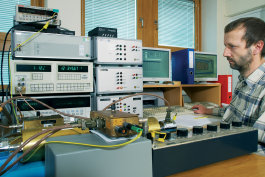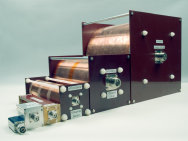AC Voltage and Alternating Current
Realization of the units of alternating electric quantities
Electric alternating quantities – voltage and current – are measured through reduction to the more precise measurable DC quantities (AC-DC-Transfer). Presently, the most accurate method is the comparison of direct voltage and alternating voltage with thermal converters.

Simply envision them as plain electric bulbs that are heated to the same temperature at AC and DC current. To measure this temperature a thermocouple is attached to a filament. The same temperature of the heating filament at AC and DC current means that the effective value of the alternating current corresponds to an equivalent direct current with the same thermal output.

National standards are thermal converters calibrated at 1 V for voltage and at 10 mA for current by the Physikalisch-Technische Bundesanstalt (Germany). Higher or lower voltages and currents are realized with series resistances and resistive shunts by step-up and step-down methods.
Calibrations encompass AC-DC transfer instruments, alternating voltage- and alternating current measuring instruments as well as calibrators (voltage and current sources) of the highest accuracy